City of Rancho Cordova - Design Guides
Ref :
Comments provided at bottom of the page and in "italics" in the body of the page.
,
Lighting 2:68
SITE DESIGN > LIGHTING
DESIGN OBJECTIVE (Page #68)
Lighting shall contribute to site safety and security and complement the built form while not detracting from the
overall quality of the site or surrounding uses and activities.
DESCRIPTION
Primary purpose of site lighting is to provide minimum lighting levels for security purposes in pedestrian and
parking areas. Centers are places with daytime and often nighttime activities. Site lighting should not detract
from the overall appearance of the site. It should not contribute to “light pollution” and should not negatively
affect surrounding uses. Lighting should be designed to satisfy both functional and decorative needs and
should relate to the pedestrian user. Storefront lighting should complement to architectural style of the building
while providing illumination of building facades and entrances.
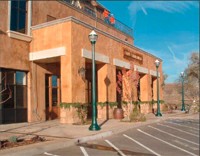 Example #1 Page 68
Properly used and represented in a "historic district". This is not Rancho Cordova. Rancho Cordova dates back to 1960s. |
Do This: The El Dorado Town Center, in El Dorado County, California uses a variety of light fixtures both on and off the building that integrate with the architectural style of the structures. Fixtures are oriented to accentuate the architecture of the building or to light the pedestrian path. While maintaining the visual integrity of the fixture, tall fixtures are capped or muted at the top to reduce light pollution. |
This represents
one of the most offensive fixture in common use. These
fixtures should only be used in historic districts (AS SHOWN) and only fixtures
which qualify as full cutoff. Many other decorative style
fixtures are available. See for examples. See also Skykeepers Lighting Examples. |
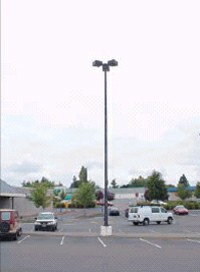 |
Example #2 Page 68 Don’t Do This: This light fixture is very tall and oriented to light only the parking area. It is out of scale with the rest of the development. |
This should not be a "Don't". It just represents on of the options to a lighting designer. Other lighting should be used closer to the building. Other considerations are Title 24 which requires energy efficiency. |
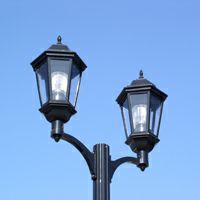 In this case hight output Metal Halide
coupled with a refractive element make for considerable glare and up
light. A Gross
Polluter. In this case hight output Metal Halide
coupled with a refractive element make for considerable glare and up
light. A Gross
Polluter. |
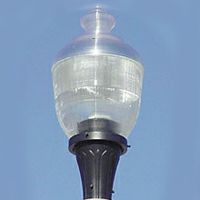 Another example of a
Gross Polluter |
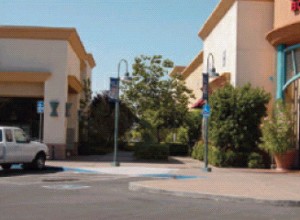 Example of Good Lighting from the
City of Elk Grove Design Guides. |
DESIGN GUIDELINES (Page #69)
1. Exterior lighting shall be designed as an integral part of the building and landscape design. Lighting fixtures shall be architecturally consistent with the overall site design and character. Creativity in fixture design is encouraged.
2. Lighting in parking areas shall be limited in scale (height) and shall be of a design that is consistent with the overall site architecture and style.
3. Limit the amount of site lighting to reduce overall light pollution generated by the project. Shield or screen lighting fixtures to direct the light downward and prevent light spill on adjacent properties.
4. In general, the location of lighting should respond to the anticipated use and not exceed the amount of illumination
required by users, such as:
• Pedestrian-scaled lighting along walkways through parking lots;
• Fixtures concealed or integrated into the design of buildings and site landscaping, walls and stairs;
• Regular and consistent spacing of compatible lighting fixtures to reinforce visual order.
Continued on (Page #70)
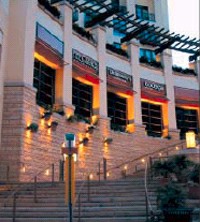 Example #1 Page 69
|
The lighting at this shopping center in Pasadena, California accentuates the architecture without contributing to light pollution. |
This should not be considered a good example of quality lighting. |
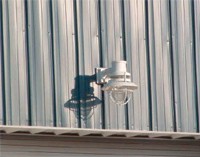 Example #2 Page 69
|
This lighting fixture on the side of an industrial building in Rancho Cordova, California is compatible with the architecture of the building and is shielded. |
This lighting fixture is NOT shielded sufficiently to address the Objectives or Standards. The lamp and refractive elements of this fixture are observable from off site and the light fixture contributes to sky glow and light pollution in the reason. |
DESIGN GUIDELINES Continued (Page #70)
5. Building lighting shall be directed onto the façade, entrance areas of buildings, or onto pedestrian pathways only as a way to increase site safety and accentuate the architecture of the building without creating or otherwise contributing to light pollution.
6. Light fixtures taller than six feet should be separated from trees that have canopies between 20 and 30 feet by a minimum distance of 20 feet.
This is intended to reduce potential damage to the light fixture and minimize the need to prune the tree in order to maintain adequate down lighting from the fixture. The City is willing to consider other design solutions that meet the intent of this guideline. ( Wonderful! )
DESIGN STANDARDS
| 1.
In order to minimize light trespass on residential properties directly
abutting a multi-family site, illumination measured at the nearest
residential property line shall not exceed the moon’spotential ambient illumination of one-tenth foot-candle. 2. The maximum height for all freestanding light fixtures on private property shall be 18 feet from finish grade. 3. The following types of lighting are prohibited: • Overly bright or excessive lighting • Lighting which spills into residential areas or onto adjacent street rights-of-way • Light poles that obstruct pedestrian traffic • Security spotlight (except in loading areas and building entrances) • Moving, flashing, or animated lighting |
------- END Review Chapter 2 -------
, http://www.cityofranchocordova.org/documents/planning/design_guidelines/chapter_6.pdf
DESIGN GUIDELINES (Page #17)
2. Use landscaping to enhance the pedestrian experience:
• Soften large building walls and screen objectionable views with landscaping;
• Provide shade with trees and structural elements;
• Use combination of landscape, paving elements, furniture, lighting and other elements to create dynamic visually interesting
outdoor spaces.
------- END Review Chapter 6 -------
Review of Rancho Cordova Design Guidelines
Appendix B,
Rancho Cordova Design Guidelines
Provisions for a Quality Community B:1
APPENDIX B
Chapter 2
Checklist for Project Review
RANCHO CORDOVA DESIGN GUIDELINES
A. COMMUNITY DESIGN CHECKLIST FOR ALL PROJECT TYPES
------- Review Section #1 -------
SITE DESIGN > SAFESCAPE (2:58) (Page# 11)
OBJECTIVE: Create safe, inviting, pedestrian places that incorporate crime prevention design elements and emphasize linkages and
surveillance between the buildings and the street.
DESIGN GUIDELINES
9. Night lighting illuminates passageways and building entrances. (Page# 12)
------- Review Section #2 -------
SITE DESIGN > ART IN PUBLIC PLACES (2:66) (Page# 13 - 14)
4. Buildings are designed a public art through their articulation, architectural
style/features, and lighting. (Page# 14)
------- Review Section #3 -------
SITE DESIGN > LIGHTING (2:68) (Page# 14)
OBJECTIVE: Lighting shall contribute to site safety and security and complement the built form while not detracting from the overall
quality of the site or surrounding uses and activities.
DESIGN STANDARDS
1. In order to minimize light trespass on residential properties directly abutting a
multi-family site, illumination measured at the nearest residential property line shall
not exceed the moon’s potential ambient illumination of one-tenth foot-candle.
2. The maximum height for all freestanding light fixtures on private property is 18
feet from finish grade.
3. Prohibited lighting is not used as part of the project.
DESIGN GUIDELINES
1. Exterior lighting is an integral part of the building and landscaping.
2. Lighting in parking areas is consistent in scale and style with the rest of the
project.
3. Light pollution (spill on adjoining property) is minimized.
4. The location of lighting responds to the anticipated use and does not exceed
the amount of illumination required by users (three provisions listed for
implementation).
5. Building lighting is directed onto appropriate areas of the site.
------- END Review APPENDIX B -------
Comments:
This Design Guide marks a very good effort to reduce Light Trespass and Glare but fall short in preventing "Urban Sky Glow".
To "avoid light spill and glare on adjacent properties" is wonderful however it does not protect the Dear Creek Hills to the south east, or American River Parkway to the north.
"Exterior building and site lighting shall be designed so that light is not directed off site" can and should be interpreted as no spill light beyond the property on which the light originates.
1. In order to minimize light trespass on residential properties directly abutting a multi-family site, illumination measured at the nearest residential property line shall not exceed the moon’potential ambient illumination of one-tenth foot-candle.
This is an excellent way of defining Light Trespass in a suburban or rural setting.
However Deep Twilight = 0.1 fc and the Full Moon = 0.01fc are the accepted values.
Light Trespass not exceeding 0.01fc after curfew hours should be considered a standard.
It is similar to and in some ways superior to the idea in the Yocca Valley Ordinance, San Bernardino County -
(h) "Light Trespass" means nuisance glare from any lighting onto neighboring property that interferes with viewing of night sky or eliminates the ability to have darkness on the adjacent property or shines into neighboring windows and all or any areas on neighboring properties or structures. Quantitative measurement of light trespass shall be with a standard yard stick (3 ft x 1.5 in.). The yard stick shall be placed at the building setback line in the complainants yard. The yard stick shall be in contact with the ground and in a vertical position. The enforcement personnel shall than determine if a shadow is cast by the light source. The light source, yard stick, and shadow must be in alignment. Measurements shall not be taken when there is a moon in the night sky.
------- END REVIEW -------